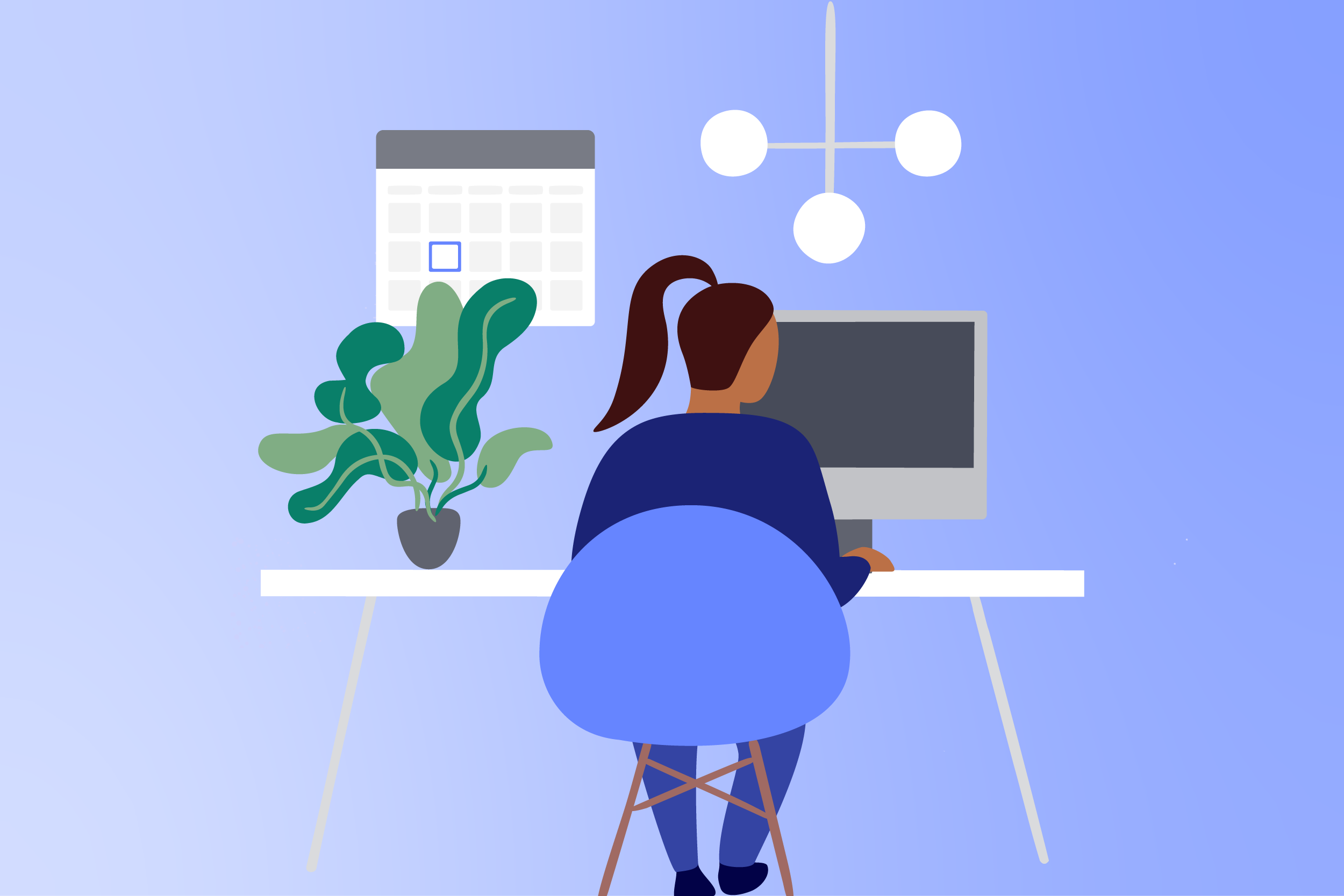There are many perks to working from home, you can wear stretchy pants and silly socks all day long, you get to have your pet as your work BFF, and you don’t have to resort to eating lunch in your car when you need to step away from the computer for a mental refresh. As wonderful as these little luxuries are, they’re probably not going to be the reason you are successful. Just like at any on-site job, your workspace needs to be set up in a way that encourages productivity so that you can accomplish what you need to and deliver quality work to your employer.
I have been working from home full-time since 2017, and I feel like even now, I’m still constantly learning more about what I need to stay on track and meet deadlines. I’ll be the first to admit that it’s not always easy to stay focused when you work from home. For instance, when I’m feeling less than enthusiastic about working, there is no shortage of excuses I can find to help me procrastinate, such as, “I need to empty the dishwasher” or “I just need to fold this basket of laundry quickly.” Suffice to say, if you’re looking for expert tips for staying 100% focused while working from home, I’m probably not your girl.
What I can do, though, is share what I’ve discovered works for me and where I think the most attention should be paid when setting up your home office and or workspace. Of course, everyone is different, so there isn’t a one-size-fits-all approach here, but you can split priorities into three categories: comfort, focus and productivity, and break time.
For Comfort
You already know that if you’re trying to work in a rock-hard chair or using a desk that requires you to position yourself to use awkwardly, you’re going to last about 25 minutes in that workspace before you have to get up and stretch (or take an Advil). While regular breaks throughout the workday can be helpful, having to frequently stop because you’re uncomfortable will likely have the opposite effect. So, your priority should be investing in whatever you need to be comfortable whether a new chair, a footrest, a standing desk, or a mount to better angle your laptop.

The cost of these things can quickly add up, so be sure to check with your employer to see if they offer any kind of reimbursement to help. If your company does not reimburse for home office equipment, keep your receipts because you might be able to deduct some of the purchases from your taxes, depending on your situation.
A truly comfortable working space requires more than just an ergonomic chair and a well-placed computer screen if you’re anything like me. One of the benefits of working from home is that you’re not in a lifeless cubical, so you have the freedom to decorate your space however you want to fit your personality so that you don’t mind spending most of your day there. This concept applies to whether your desk is set up in the corner of a shared space or if you have your own office. Either way, put up some pictures and pick up a scented candle to burn. At the same time, you work, personalize your desk with some gold hardware or a pop of color, get some flowers or a plant to add some life, and find a desk or floor lamp that warms up the space on a cloudy day. Claim this area as your own and dress it up as much or as little as you want to make it comfortable.
For Focus & Productivity
Creating a space where I am focused and productive can be difficult for me because, over the years, I’ve found that I need just enough stimulation to energize myself, but not so much that it distracts me. It’s a truly delicate balance, and once my husband started working from home with me during the worst of the pandemic, I quickly learned that everyone has little things that they know do or do not help them stay on task throughout the day.
I can’t stand visual clutter. If I’m working in a messy room or just have stuff everywhere, I cannot focus on anything except that mess. So, my office is painted in a calming shade of grey, there is balance and symmetry in everything hanging on the walls, and all of my decor is in solid colors because patterns can be too distracting for me. I also have a Google home in my office so that I can turn on white noise if I’m struggling to drown out the sounds of lawnmowers and kids playing outside, and I have a pair of noise-canceling earbuds for when I need backup.
You may already know the things that distract you, and if that’s the case, do whatever you can to eliminate them from your workspace.

If you’re still learning what your ideal working environment is, get a pad of paper and a pen and make a note of what’s distracting you every day for a week and see if you can spot a trend. If so, are there ways you can reduce or eliminate the distraction? Maybe you need a basket of snacks nearby, so you stop getting up to go to the kitchen so often, or you could use a smart device that will set reminders and add things to your grocery list with simple voice command so that you can create a to-do list for later. Similarly, if you’ve found something that helps you be more productive (like my white noise), is there a way you can implement it more into your workspace? If not, is there an alternative that could work?
For Meaningful Breaks
Taking regular, short breaks throughout the day can help with productivity and improve your quality of work. However, this can be difficult when you’re working from home because instead of walking down to the break room when you’re feeling a bit sluggish, at home, you’re dangerously close to your cozy bed that’s just begging for you to take a nap in it. So, it’s essential to develop ways that will allow you to take a short break without pulling you out of your work mode.
I also have a small couch, a TV, and a shelf with books and magazines in my office. If I need to step away, I try my best to stick to this cozy space rather than leave my office because I find that I will get easily sidetracked by little tasks I should do around the house (which turn a 10-minute break into a 30-minute distraction). Not everyone is like this. For example, my husband would take 15-minute walks outside twice a day because the fresh air really helps him reset. You may have to do a little self-research to see what works and what doesn’t for you, but if you’re doing so intentionally, you’ll probably figure it out relatively quickly.
Helpful Apps
Of course, never forget that technology is your friend when it comes to productivity. I rely on timers to help me stay on track, and I don’t know what I’d do if I couldn’t easily set reminders with a simple “Hey Google.”
Like everything else on this list, what works for one person might not work for another. But, since you have to start somewhere to find what does help, here are a few apps that may help you out:
- Toggl for time management
- DoorDash, GrubHub, Uber Eats, and or Postemates for food delivery from nearby restaurants
- Instacart for grocery order and delivery
- Time Out to help you schedule breaks throughout the day
- Target, Amazon, Walmart (or your retailer of choice) to quickly order office supplies or set up subscriptions for regular delivery of coffee or printer paper
Final Thoughts
What is so difficult about working on-site is that the workspaces are uniformly designed in a way that is supposed to work for everyone, but it rarely does. If you struggle in an office environment, then you may find that the freedom to create a workspace at home will allow you to thrive and reach your potential. Take a week to pay attention to what motivates you throughout the day and what has the power to steal your concentration, then use that information to build out a space that’s perfect for you.
Join a community that cares
Navigating work and parenting is a balancing act. Join The Mom Project to access job opportunities, career development resources and connect with a network of professionals that value work and family. 



